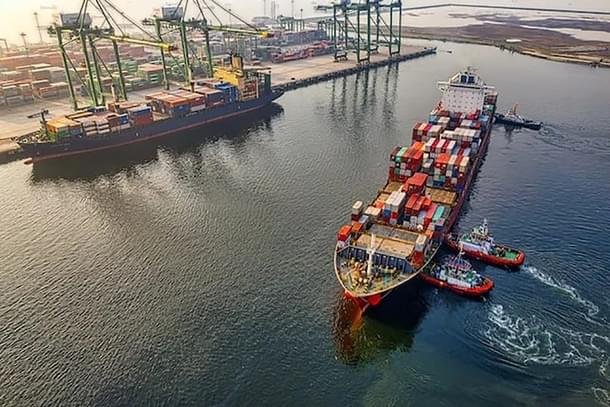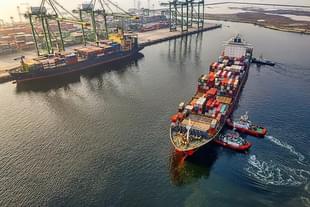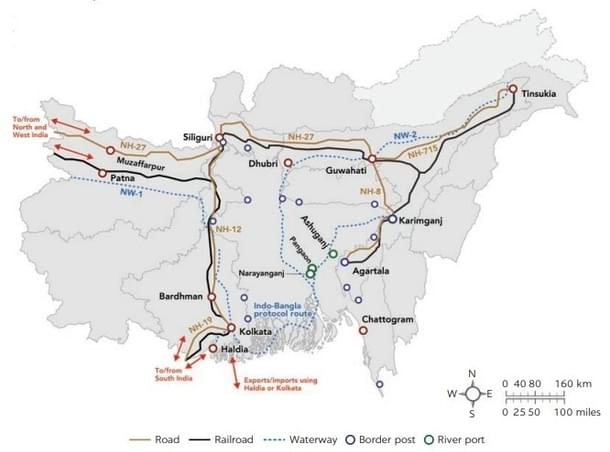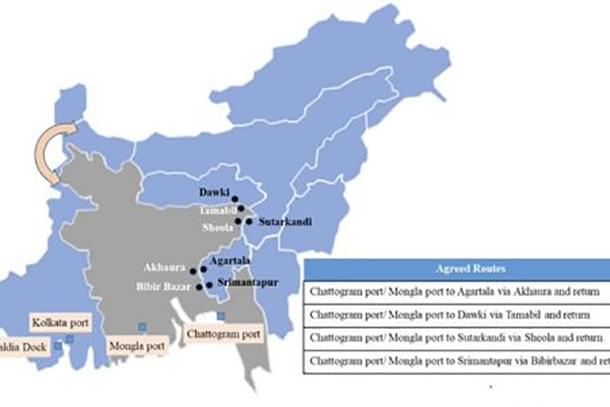Infrastructure
Explainer: Unlocking India’s North East To Bay Of Bengal Through New Transit Agreement With Bangladesh
Ankit Saxena
May 14, 2023, 03:12 PM | Updated 03:12 PM IST
Save & read from anywhere!
Bookmark stories for easy access on any device or the Swarajya app.


On 25 April 2023, the National Board of Revenue (NBR) of Bangladesh issued a “permanent transit order” for India to facilitate transit and transshipment of cargo on two major ports of Bangladesh.
The permit stated the trans-shipment of cargo will be done in line with standard operating procedures finalised by the two countries under an agreement signed in 2018.
With this bilateral development, India has received access to Chattogram (Chittagong) and Mongla ports in Bangladesh — opening up the landlocked north-eastern states to the Bay of Bengal, significantly reducing distance and expenses for movement of goods.
Bangladesh Prime Minister Sheikh Hasina had earlier stated the use of the Chittagong Port to India when External Affairs Minister S Jaishankar called on her in Dhaka, emphasising that the port would be of benefit to the North East India.
As per a recent statement, Bangladesh’s Minister of State for Shipping, Khalid Mahmud Chowdhury, said, “We are ready for the start of transit and trans-shipment of goods between Bangladesh and the northeastern region of India through Chittagong. Trial runs were completed and all arrangements for immigration and customs formalities on the Bangladesh side are also ready.”
The North East region is positioned to serve India’s strategic vision encompassed in the Act East Policy.
The region sits at the door-step of the Eastern Asia, with which India is seeking to enhance its economic relations.
However, the area is yet to tap into its strategic potential due to several factors, largely attributed to its remote location and lack of connectivity with the rest of India.
The seven northeast Indian states contribute only 2.8 per cent to India’s GDP (gross domestic product), according to a World Bank report.
This distribution further is highly skewed — with Assam contributing about 61 per cent of the region’s GDP, followed by Tripura at 9 per cent and Meghalaya at 7 per cent, as per the Reserve Bank of India.
However, economically, the region has large deposits of oil, natural gas, coal, and limestone, and a sizable proportion of land under cultivation for agro-horticulture products, bamboo, and rubber.
In recent times, the country has prioritised improving trade and connectivity in the northeast, through a number of multimodal projects, while connecting them with the rest of India and the Association of Southeast Asian Nations (ASEAN).
Given ASEAN’s significance, the region becomes important for India’s foreign policy manoeuvres as the only land ‘bridge’ between India and Southeast Asia.
As per a 2022 Mint report, India’s North East region has witnessed more than 85 per cent growth in the export of agricultural products over the last six years.
There has been a significant increase in export of agricultural produce from all of the northeastern states.
The major destinations of export have been Bangladesh, Bhutan, the Middle East, the UK and Europe.
Over the years, the North East region has played a crucial role in boosting bilateral relations between India and Bangladesh.
In 2015, the two governments signed a protocol enabling India to utilise four riverways via Bangladesh — connecting Kolkata and Murshidabad to Assam, Tripura and Meghalaya.
The recent agreement on access to ports, improving coastal shipping and freight traffic routes, is also a step of the broader strategy to strengthen India's ties with its neighbour.
Sea-Link For India’s Landlocked North East
Of the seven states in the region — Assam, Meghalaya, Tripura and Mizoram — share a 1,879 km border with Bangladesh.
As part of the efforts, many of the pre-partition trade routes are also being revived, most of which lead to Chittagong Port.
Also known as the Chattogram Port, it is Bangladesh’s main seaport and is located on the banks of the Karnaphuli River in the country’s southeast and manages over 90 per cent of the country’s overseas commerce.
Additionally, the Mongla Port is the country’s second largest seaport situated on the Bay of Bengal.
Currently, most of the movement to the region is channelled through the "chicken's neck", — a narrow strip in Siliguri, West Bengal.
Around 95 per cent of exports from Assam, Meghalaya, Manipur, Nagaland and Arunachal Pradesh are transported by road through this Siliguri corridor to Kolkata and Haldia ports, while the remaining 5 per cent is carried by rail through the same corridor.

According to World Bank, despite its abundant natural resources, the North East region has been hampered by poor connectivity and high transportation costs for goods.
For instance, goods from Agartala in Tripura have to travel 1,600 km through the Siliguri corridor to reach Kolkata Port instead of just 450 km through Bangladesh.
With the recent access, the distance will significantly reduce, as goods from Agartala only need to travel to reach Chattogram Port in Bangladesh.
As a result, transportation costs to the port have reduced by 80 per cent, as per World Bank officials.
Additionally, a major percentage of exports from the region are also projected to use the Chattogram Port.
A total of 16 transit routes have been declared allowing cargo transportation from Chattogram or Mongla Port — through which landlocked Assam, Meghalaya and Tripura states could access open water routes.

Increasing Infrastructure In Both Countries To Support Trans-Shipment Routes
In March 2021, the prime ministers of the two countries inaugurated the Maitri Setu — a 1.9 km bridge built over the Feni River, which has reduced the distance between Sabroom in southern Tripura and the Chattogram port to just 111 km.
The government is working on a multi-modal transit hub at Sabroom inclusive of road and rail connectivity that can help goods reach the Chittagong Port in a few hours.
Similarly, road connectivity in Meghalaya’s Dawki, southern Assam’s Sutarkandi and Tripura’s Akhaura linking eastern and south-eastern Bangladesh is also being improved.
Mizoram is keen on bridges across the Khawthlangtuipui river (Karnaphuli in Bangladesh) for faster access to the Chittagong Port.
In line with these developments, it is essential to augment regional infrastructure to meet the increasing demand and improve trade and commerce in these regions.
According to various reports, there are infrastructural deficiencies at several border points in the North East region of India — impeding growth by persistent constraints and long delays.
Border infrastructure challenges include limited warehouse space, a lack of essential equipment like cranes or weighbridges, inadequate testing laboratories in the vicinity, restricted truck parking areas, and the absence of a cargo dump yard.
Simultaneously, India is also making efforts to improve infrastructure in Bangladesh to strengthen bilateral ties.
India has extended three lines of credit amounting to $7.5 billion, primarily for infrastructure.
This includes constructing a bay container terminal at Chattogram Port, expanding Mongla Port, and building four-lane highways along the Ramgarh-Baruerhat, Comilla-Brahmanbaria-Sarail, and Ashuganj river port-Sarail-Dharkhar-Akhaura land port routes.





